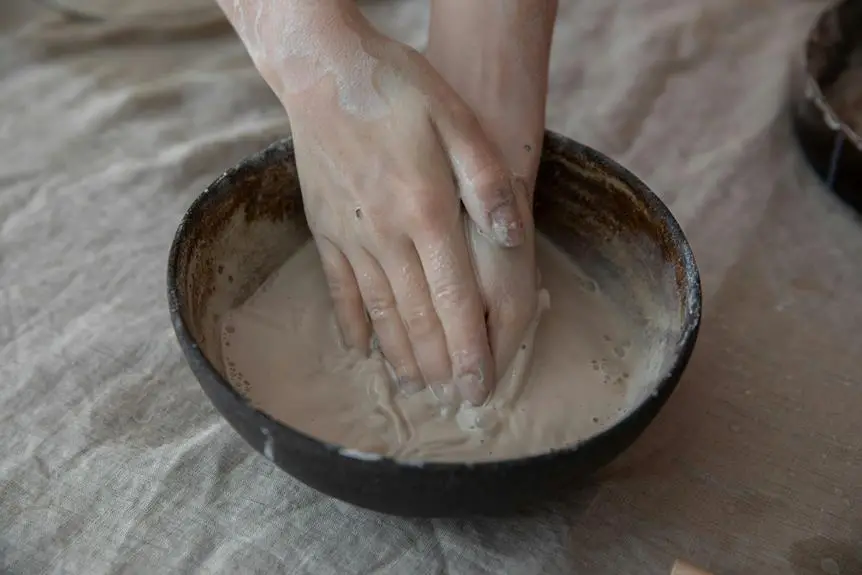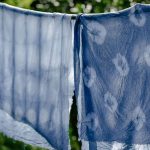When you think about sateen fabric, it's easy to appreciate its smooth feel and subtle sheen, but do you know how it's actually made? The process starts with selecting the right fibers, primarily long-staple cotton, and then employs a unique weaving technique that sets it apart from other fabrics. This isn't just about aesthetics; the weaving method plays a crucial role in the fabric's durability and drape. As you explore further, you'll discover the intricate steps that transform simple fibers into this elegant material, including the critical finishing techniques that enhance its quality.
Table of Contents
Overview of Sateen Fabric
Sateen fabric, known for its luxurious sheen and smooth texture, is created using a unique weaving technique that elevates its appearance and feel. This fabric features a satin weave, where the threads are woven in a way that creates a soft, glossy surface. You'll often find sateen made from cotton, though it can also incorporate blends with other fibers to enhance its characteristics.
One of the standout features of sateen is its ability to drape beautifully, making it a popular choice for bedding, clothing, and upholstery. When you touch sateen, you'll notice its silky feel, which adds an element of comfort and elegance to any item made from it.
Sateen's sheen comes from the way light interacts with its surface, giving it a rich, lustrous appearance that can elevate even the simplest designs. Additionally, because of its tightly woven structure, sateen is often more resistant to wrinkles, making it a practical choice for everyday use.
Choosing the Right Fibers
When selecting fibers for sateen fabric, consider how different materials can enhance its luxurious feel and visual appeal.
Cotton is the most common choice; it offers breathability, softness, and durability. Opt for 100% long-staple cotton for a smooth finish and a rich sheen.
If you want something more lavish, you might explore silk blends. Silk adds a distinct luster and a silky touch, elevating the overall elegance of the fabric. However, keep in mind that silk can be more delicate and requires special care.
Another option is rayon, which mimics the softness of silk but is typically more affordable. Blending rayon with cotton can result in a beautiful sateen with a soft drape and sheen.
For eco-conscious choices, consider organic fibers or sustainable materials like Tencel, which offers a luxurious feel and is biodegradable.
Ultimately, your choice of fiber will influence not just the look and feel of the sateen but also its durability and maintenance needs. Think about your intended use and personal preferences to find the perfect fiber blend that meets your needs.
The Weaving Process
To create sateen fabric, manufacturers use a unique weaving technique that enhances its signature smoothness and sheen. This process primarily involves a four-over, one-under weave, which means that four yarns go over one yarn. This method allows the fibers to lie flat, resulting in a luxurious feel. As you explore the weaving process, you'll notice how it differs from traditional cotton fabrics.
Here are some key aspects of the weaving process for sateen:
- Warp and Weft: The warp yarns run lengthwise, while the weft yarns run across the fabric, contributing to its overall structure.
- Yarn Selection: High-quality, long-staple cotton fibers are typically chosen to ensure a soft touch and durability.
- Tension Control: Manufacturers carefully control the tension during weaving to prevent puckering and ensure an even finish.
Finishing Techniques
Now that you've learned about the weaving process, it's time to explore the finishing techniques that give sateen fabric its signature look and feel.
You'll see how the heat setting process and various chemical treatments play crucial roles in enhancing the fabric's durability and appearance.
These steps are essential for achieving the luxurious finish that sateen is known for.
Heat Setting Process
The heat setting process stabilizes sateen fabric, ensuring it retains its smooth texture and vibrant colors after production. This crucial finishing technique involves applying heat to the fabric, which helps to set the fibers in place. By doing this, you significantly reduce the risk of fading, wrinkling, or distortion, allowing the fabric to maintain its luxurious appearance over time.
During the heat setting, the fabric is typically passed through a series of heated rollers or plates, which evenly distribute the heat. This process also enhances the fabric's drape and feel, making it even more inviting.
Here are some key benefits of heat setting sateen fabric:
- Color Retention: Keeps colors bright and prevents fading.
- Shape Stability: Reduces the likelihood of distortion during use or washing.
- Enhanced Softness: Improves the overall feel of the fabric, making it more comfortable against the skin.
With the heat setting process, you can enjoy sateen fabric that looks and feels great every time you use it.
Chemical Treatments Overview
Chemical treatments play a vital role in enhancing the properties of sateen fabric, ensuring it meets the demands of both aesthetics and performance. You'll find that these treatments can improve durability, stain resistance, and overall appearance. One common technique is applying a softener, which gives the fabric that luxurious, smooth feel you love.
Another essential treatment involves anti-wrinkle agents. These help maintain a crisp look, reducing the need for frequent ironing. If you're concerned about stains, you might appreciate the application of water-repellent finishes that shield the fabric from spills, making it easier to maintain.
Moreover, some chemical treatments enhance colorfastness, ensuring that the vibrant hues of sateen remain intact through multiple washes. You might also encounter treatments that add UV protection, making your sateen fabric suitable for outdoor use.
Dyeing Sateen Fabric
When it comes to dyeing sateen fabric, you'll encounter various techniques that can enhance its luxurious look.
Understanding the importance of colorfastness is crucial, as it ensures your vibrant hues stay intact over time.
Let's explore these methods and what makes them effective for sateen.
Dyeing Techniques Overview
Dyeing sateen fabric involves various techniques that enhance its luxurious sheen and vibrant colors. When you're selecting a dyeing method, it's crucial to consider the fabric's characteristics to achieve the desired effect.
Here's an overview of some popular dyeing techniques:
- Reactive Dyeing: This method uses dyes that chemically bond with the fabric, resulting in bright and long-lasting colors.
- Disperse Dyeing: Often used for polyester blends, disperse dyes create vivid hues and excellent color retention through a process that involves heat.
- Pigment Dyeing: This technique applies pigments to the fabric surface, allowing for a wide range of colors while giving a softer feel.
Each technique offers distinct advantages, allowing you to customize the look and feel of your sateen fabric.
Colorfastness in Sateen
Colorfastness is crucial for maintaining the vibrant hues of your sateen fabric after washing and exposure to sunlight. When you choose sateen, you're likely drawn to its luxurious sheen and rich colors. However, without proper colorfastness, those beautiful shades can fade or bleed over time.
To ensure your sateen fabric retains its brilliance, manufacturers often use reactive dyes, which bond well with the fibers. This process helps create a more durable color that's less likely to wash out. You should also look for fabrics that have been treated with color-fixing agents, as these can significantly enhance color retention.
When caring for dyed sateen, always follow the washing instructions on the label. Washing in cold water and using a gentle detergent will help preserve the colors.
Avoid prolonged exposure to direct sunlight, as UV rays can cause fading. If you ever need to iron your sateen, use a low heat setting to prevent any damage to the fibers.
Quality Control Measures
To ensure the highest standards in sateen fabric production, manufacturers implement rigorous quality control measures throughout the entire process. These measures help you receive a product that not only meets your expectations but also stands the test of time. Each phase, from raw material selection to the final inspection, is carefully monitored to maintain quality.
Here are some essential quality control measures:
- Material Inspection: Before production begins, manufacturers inspect raw materials for defects, ensuring only the best cotton fibers are used.
- Weaving Checks: During the weaving process, operators monitor for inconsistencies, such as tension issues or broken threads, to guarantee a smooth finish.
- Dye Testing: After dyeing, samples undergo colorfastness tests to confirm that colors remain vibrant and don't fade easily.
Applications of Sateen Fabric
Sateen fabric's luxurious sheen and softness make it a popular choice for a variety of applications, from elegant bedding to stylish clothing. You'll often find sateen used in bed linens, where its smooth surface enhances comfort and sleep quality. Many people prefer sateen sheets and pillowcases because they feel soft against the skin and have a beautiful luster that elevates any bedroom decor.
In addition to bedding, sateen is a go-to fabric for clothing, especially for dresses, blouses, and skirts. Its drapability allows garments to flow gracefully, making it perfect for formal occasions or casual outings. You can easily dress up a simple top made of sateen with accessories for a chic look.
Sateen is also used in home decor, including curtains and table linens, where its sheen adds a touch of elegance. You might appreciate how it can elevate your living spaces by creating a refined atmosphere.
Frequently Asked Questions
What Is the History of Sateen Fabric Production?
You'll find that sateen fabric's history dates back to ancient times, evolving through various cultures. It gained popularity in Europe during the 19th century, thanks to its luxurious feel and elegant appearance, enhancing textiles significantly.
How Does Sateen Differ From Regular Cotton?
Sateen differs from regular cotton mainly in its weave. You'll notice sateen's smoother, shinier surface, created by a unique weaving technique that gives it a luxurious feel, while traditional cotton has a more matte finish.
Can Sateen Fabric Be Eco-Friendly?
Yes, sateen fabric can be eco-friendly! When you choose organic cotton sateen, you're opting for sustainable practices. Many brands now use eco-conscious dyes and production methods, helping reduce environmental impact while maintaining quality and comfort.
What Are the Common Uses for Sateen Beyond Textiles?
You'll find sateen used in various applications beyond textiles, like upholstery, drapery, and even bedding. Its smooth finish and slight sheen make it a popular choice for enhancing aesthetic appeal in home decor and fashion accessories.
How Should I Care for Sateen Fabric?
To care for sateen fabric, wash it gently in cold water with a mild detergent. Avoid bleach, and tumble dry on low. Iron on a low setting to maintain its smooth, luxurious finish.
- How Does Ring Spun Cotton Affect Garment Fit and Shape Retention? - August 13, 2024
- What Are the Challenges in Producing Ring Spun Cotton? - August 13, 2024
- Is Ring Spun Cotton Suitable for Plus-Size Clothing? - August 13, 2024







